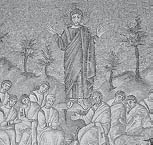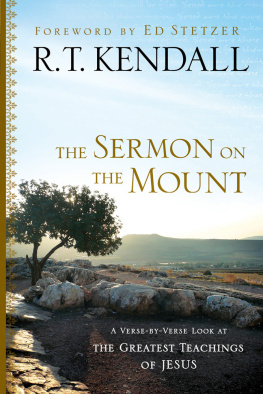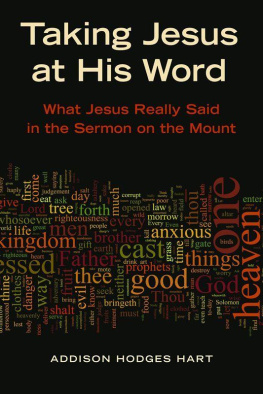Sermon on the Mount
Sermon on the Mount:
A Beginners Guide to the Kingdom of Heaven
978-1-5018-9989-8
978-1-5018-9990-4 eBook
Sermon on the Mount: DVD
978-1-5018-9993-5
Sermon on the Mount: Leader Guide
978-1-5018-9991-1
978-1-5018-9992-8 eBook
Also by Amy-Jill Levine
Entering the Passion of Jesus:
A Beginners Guide to Holy Week
Light of the World:
A Beginners Guide to Advent
AMY-JILL LEVINE
SERMON on the MOUNT
A BEGINNERS GUIDE TO THE KINGDOM OF HEAVEN


SERMON ON THE MOUNT
A BEGINNERS GUIDE TO THE KINGDOM OF HEAVE
Copyright 2020 Amy-Jill Levine
All rights reserved.
No part of this work may be reproduced or transmitted in any form or by any means, electronic or mechanical, including photocopying and recording, or by any information storage or retrieval system, except as may be expressly permitted by the 1976 Copyright Act or in writing from the publisher. Requests for permission can be addressed to Permissions, The United Methodist Publishing House, 2222 Rosa L. Parks Blvd., Nashville, TN 37228-1306 or e-mailed to .
Library of Congress Control Number: 2020936870
ISBN-13: 978-1-5018-9989-8
Scripture quotations unless noted otherwise are from the New Revised Standard Version Bible, copyright 1989 National Council of the Churches of Christ in the United States of America. Used by permission. All rights reserved worldwide. http://nrsvbibles.org/
Scripture quotations marked (KJV) are from The Authorized (King James) Version. Rights in the Authorized Version in the United Kingdom are vested in the Crown. Reproduced by permission of the Crowns patentee, Cambridge University Press.
Quotations from the Mishnah, including Pirke Avot, are taken from Jacob Neusner, The Mishnah: A New Translation (New Haven, CT: Yale University Press, 1991).
Quotations from the Babylonian Talmud are taken from the William Davidson Talmud, Sefaria.org, www.sefaria.org/texts/Talmud.
Quotations from the Dead Sea Scrolls are taken from Michael Wise, Martin Abegg Jr., and Edward Cook, The Dead Sea Scrolls: A New Translation (San Francisco: HarperSanFrancisco, 1996).
20 21 22 23 24 25 26 27 28 2910 9 8 7 6 5 4 3 2 1 MANUFACTURED IN THE UNITED STATES OF AMERICA

Dedicated with special gratitude to The Temple (Congregation Ohabai Shalom) in Nashville, Tennessee, which has for two decades welcomed not only Jews but also Christians and the religiously unaffiliated to study with me, for three weeks a year, texts and histories that Jews and Christians share, including the Sermon on the Mount. Those nights at The Temple are evidence of the kingdom of heaven in our midst.

CONTENTS

INTRODUCTION
Who Wants to Read a Sermon?
When I first read the Gospel of MatthewI must have been about thirteen or fourteenI didnt have much interest in the Sermon on the Mount. The Christmas story with the magi and the slaughter of the innocents, the Baptism, Jesuss calling his first four disciples, the Temptation (loved the Temptation! Jesus 3, Satan 0)all these action-filled, character-driven passagesthese fascinated me. And then Matthew 57, the Sermon. The Bible I had titled these three chapters The Sermon on the Mount, and the very word sermon stopped me. I didnt want to read a sermon. Given the number of sermons I had heard in my junior congregation services at my hometown synagogue, I was pretty sure that sermon was synonymous with boring or obvious. In the local Catholic church that I attended with friends, I had heard a few homilies (for a while I thought the term was hominies, like grits). The only thing that made homilies better than sermons was that they tended to be shorter.
Who wants to read a sermon, even if it is by Jesus? I skipped over Matthew 57 fairly quickly and then got to the good parts where Jesus starts healing people and arguing with other Jews.
When I got to college and took Introduction to the New TestamentI was eighteenI still didnt have much interest in the Sermon on the Mount. The reasons for this lack of interest, however, had changed. When I mentioned to my Christian friends, whether in high school or in my first year of college, that I was interested in biblical studies and especially in the New Testament, many of these friends sang the same song: Oh yes, they said, we learned a lot about Jesus in church. We learned that he came to fix Judaism, which had gone downhill from the good old days of Abraham. Problems started with Moses and the Law, and then they got increasingly worse. The Jewish system was legalistic, misogynistic, xenophobic, violent, lacking in mercy, and otherwise a mess. Thats why, they told me, Jesus gave the Sermon on the Mount, with its comments about You have heard it said... but I say to you...: to replace the Torahs eye for an eye with Jesuss turn the other cheek. Thats why, they told me, Jesus had to teach his followers how to pray, because the Jews had forgotten.
Who wants to read a sermon if the whole point is to show that Judaism had devolved into something disgusting? Rather than read the text for myself, I simply took their word for it and, again, went from the Temptation in Matthew 4 to the healing of the man with leprosy in Matthew 8 (free health carewhats not to like?).
Alas, I didnt know what I was missing because I stuck with what I had been told rather than what I had learned for myself. This concern has become a guide for me now as a professor. I ask my students to think about two questions when they write their papers and sermons. The first question is, How do I know this? They need to back up their claims rather than go with what theyve always been told since their preschool days, settle for the easy answer, or retroject twenty-first-century sensibilities onto first- century texts. The second question is, Why do I care? If they can show their own interest and show how theyve been inspired by the text, they are better able to convey the good news to others.
Then, about midway through my first year at Smith College, I had an aha moment, in great measure thanks to my New Testament professor, Karl Donfried. Professor Donfried knew the history, and he knew why the text mattered. He helped me see that Jesus is not a Christian talking to other Christians; he is a Jew talking to other Jews. Hes not telling his fellow Jews to do away with Torah. That would be ridiculous. Rather, hes telling them that he has insight into the heart of Torah, and they would do well to listen to him. I started to read the Sermon on the Mount as a teaching given by one Jew to fellow Jews.
Finally, everything clicked. The Sermon on the Mount is not a sermon. Its a series of discrete teachings, each of which could be the basis of a sermon, a lecture, a community study, or a personal meditation. Had Jesus delivered all verses in Matthew 57 at one time, the disciples heads would have exploded. Theres too much in these chapters to absorb in a single lesson. Every verse is a multifaceted gem, and every line opens up to other passages in the Gospel. (You can probably sense my frustration: theres so much more to say than the six chapters in this study can contain.)
Next page











